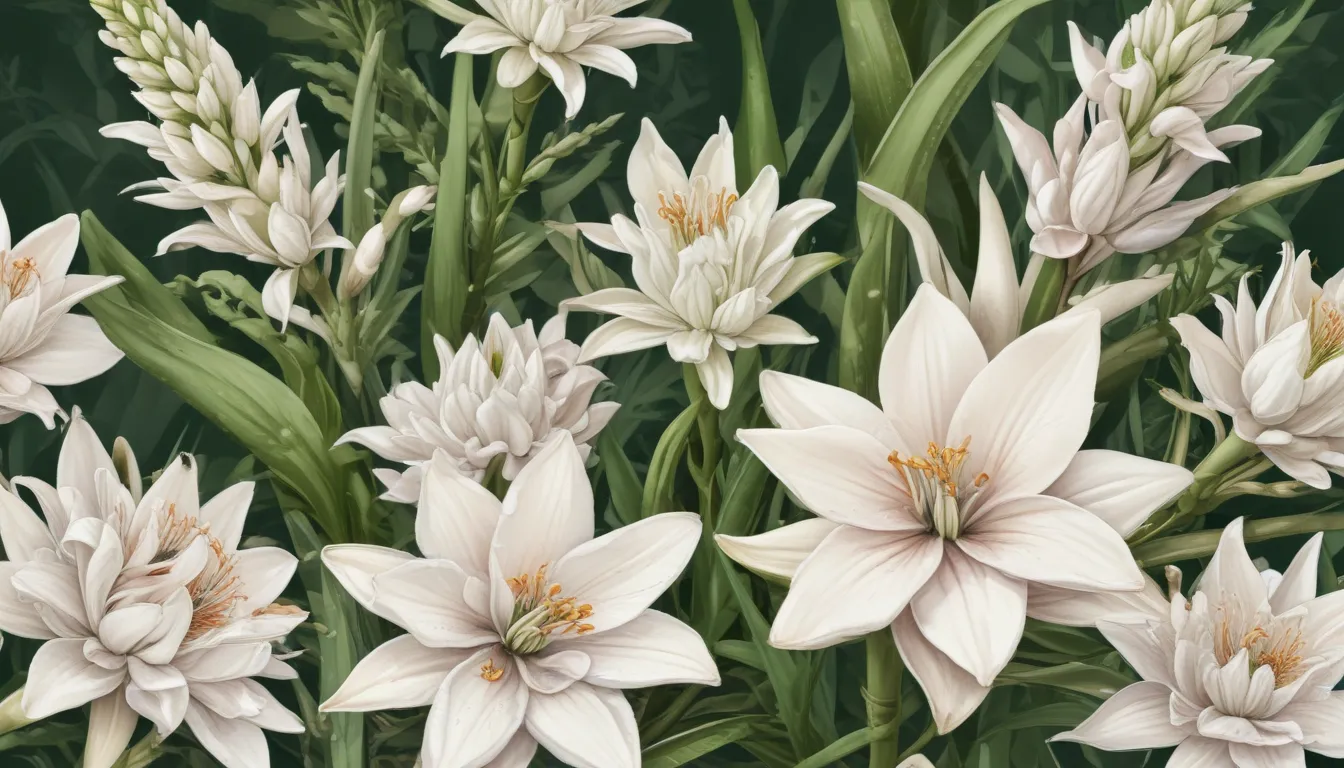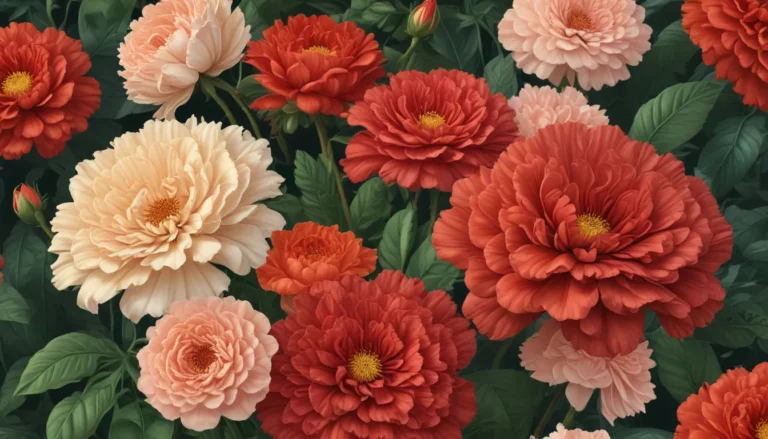The pictures we use in our articles might not show exactly what the words say. We choose these pictures to make you interested in reading more. The pictures work together with the words but don’t take their place. The words still tell you the important facts.
Are you ready to explore the mesmerizing world of tuberose, the beloved flower with an enchanting fragrance and stunning appearance? Native to Mexico and known scientifically as Polianthes tuberosa, tuberose has captured the hearts of many with its beauty and aromatic allure. In this article, we will take you on a journey through the delightful realm of tuberose, uncovering 19 captivating facts about this beloved flower. From its historical significance to its symbolic meanings, from its cultivation and uses to its prominent place in perfumery, we will delve deep into the fascinating world of tuberose. So, get ready to be mesmerized as we unravel the beauty, fragrance, and history of tuberose that make it a true obsession for flower enthusiasts worldwide.
Discover the Fascinating World of Tuberose
Tuberose: A Native Beauty of Mexico
Tuberose, scientifically known as Polianthes tuberosa, is a stunningly beautiful flowering plant that is native to Mexico. The name "tuberose" is derived from the Latin word “tuberosa,” meaning swollen or tuberous, which refers to the shape of its root. This native beauty has a rich history and cultural significance, dating back centuries in the regions where it originates.
The Enchanting Fragrance of Tuberose
One of the most noteworthy features of tuberose is its intoxicating fragrance, often described as exotic, sweet, and seductive. This captivating scent has made tuberose a sought-after ingredient in the perfume industry, where it is used as a base note in many luxurious fragrances. The allure of tuberose's fragrance lies in its richness and depth, adding a touch of warmth and sensuality to perfumes.
A Night-Blooming Beauty
Tuberose flowers bloom at night, releasing their fragrance during the nighttime hours. This unique blooming pattern is believed to attract pollinators like moths, who are more active after sunset. The nocturnal beauty of tuberose adds a touch of mystery and allure to its already enchanting presence.
Symbolism of Love and Passion
Throughout history, tuberose has been associated with love, sensuality, and passion. It is often used in bridal bouquets to symbolize deep emotional attachments and passionate love. The symbolic meanings attributed to tuberose reflect its captivating fragrance and elegant appearance, making it a favorite choice for romantic gestures and expressions of affection.
Delve Deeper Into the World of Tuberose
The Lily Family Connection
Tuberose belongs to the Asparagaceae family, which includes other well-known plants like Lily and Agave. This family connection highlights the shared characteristics of tuberose with its lily relatives, such as long, slender leaves and fragrant flowers. The association with the Lily family adds to the charm and elegance of tuberose as a beloved flower.
Vibrant Array of Colors
While white is the most common color of tuberose flowers, they can also be found in shades of pink and yellow. This vibrant array of colors adds versatility and charm to arrangements and bouquets featuring tuberose.
The Queen of the Night
Tuberose is often referred to as “The Queen of the Night” due to its exquisite fragrance and nocturnal blooming habits. This nickname underscores the elegance and allure of tuberose, emphasizing its regal presence and captivating beauty.
A Perfumery Favorite
The captivating scent of tuberose has made it a popular ingredient in floral perfumes. Its essence adds depth, warmth, and sensuality to many renowned floral fragrances, making it a sought-after choice for perfumers around the world.
Embrace the Beauty and Elegance of Tuberose
Lush Blooms and Longevity
One of the advantages of tuberose is its long vase life, with flowers lasting up to two weeks in a vase. This longevity makes tuberose an excellent choice for floral arrangements and decorations, adding a touch of elegance and beauty to any setting.
Cultivation and Cultural Significance
Tuberose is cultivated not only in its native Mexico but also in countries like India, Morocco, Egypt, and China. These regions offer favorable climates for the successful growth and production of tuberose, emphasizing its cultural significance and widespread cultivation around the world.
Luxury and Opulence
Due to its captivating fragrance and elegant appearance, tuberose is often associated with luxury and opulence. It is a symbol of sophistication and is commonly used in high-end floral arrangements and exclusive events, adding a touch of refinement and elegance to any setting.
Summer Blooms and Fragrant Beauty
Tuberose typically blooms during the summer months, filling gardens and landscapes with its beautiful, fragrant flowers. Its lush blooms and intoxicating scent make it a delightful addition to any summer garden, enhancing the beauty and allure of outdoor spaces.
Uncover the Rich History and Versatile Uses of Tuberose
Medicinal and Therapeutic Properties
In traditional medicine practices, tuberose flowers are believed to have various medicinal properties. They are used to treat ailments such as headaches, fever, and congestion, and are also used topically for skincare. The therapeutic benefits of tuberose add to its allure and make it a valuable resource in natural remedies.
Biodiversity and Pollinator Attraction
The vibrant, fragrant flowers of tuberose act as a magnet for butterflies and bees, attracting these pollinators and contributing to the overall biodiversity of the ecosystem. The role of tuberose in supporting pollinators highlights its importance in maintaining balanced and healthy ecosystems.
Myths, Legends, and Cultural Significance
Tuberose has a rich and fascinating history, with mentions of its beauty and fragrance dating back to ancient civilizations like the Aztecs and the Romans. Its history is intertwined with myths, legends, and cultural significance, making it a captivating subject for plant enthusiasts and researchers alike.
Warm Climate Requirements
Being a tropical plant, tuberose thrives in warm and humid climates. It requires ample sunlight and well-drained soil to reach its full potential and showcase its stunning blooms. Understanding the climatic needs of tuberose is essential for successful cultivation and growth.
Explore the Enchanting World of Tuberose
In conclusion, tuberose is a captivating plant that has enamored people for centuries with its stunning appearance and intoxicating fragrance. From its origins in Mexico to its widespread cultivation around the world, tuberose has become a symbol of love, luxury, and beauty. Its rich history, cultural significance, and versatile uses make it a fascinating subject for exploration and discovery. Whether you're a gardener looking to add a touch of elegance to your garden or simply someone interested in learning more about plants, delving into the world of tuberose is sure to be a rewarding experience. So, next time you encounter this enchanting flower, take a moment to appreciate its beauty and remember the captivating facts that make tuberose truly remarkable.
Unravel the Mysteries of Tuberose with FAQs
What is the meaning of tuberose?
The name "tuberose" is derived from the Latin words “tubus” meaning tube, and “rosa” meaning rose. It refers to the shape and fragrance of the flower.
Where does tuberose originate from?
Tuberose is native to Mexico and Central America, where it has been cultivated for centuries.
What is the significance of tuberose in different cultures?
Tuberose holds different meanings in various cultures, often associated with love, romance, and purity. It is used in religious ceremonies and weddings in India and symbolized forbidden pleasures in Victorian times.
How does tuberose smell?
Tuberose is known for its strong and intoxicating fragrance, described as rich, sweet, and creamy, with hints of floral and exotic notes.
Can tuberose be grown indoors?
Yes, tuberose can be grown indoors in pots or containers with proper care and maintenance. Adequate sunlight and space are essential for their successful growth.
Was this page helpful?
Our commitment to delivering trustworthy and engaging content is at the heart of what we do. Each fact on our site is contributed by real users like you, bringing a wealth of diverse insights and information. To ensure the highest standards of accuracy and reliability, our dedicated editors meticulously review each submission. This process guarantees that the facts we share are not only fascinating but also credible. Trust in our commitment to quality and authenticity as you explore and learn with us.






